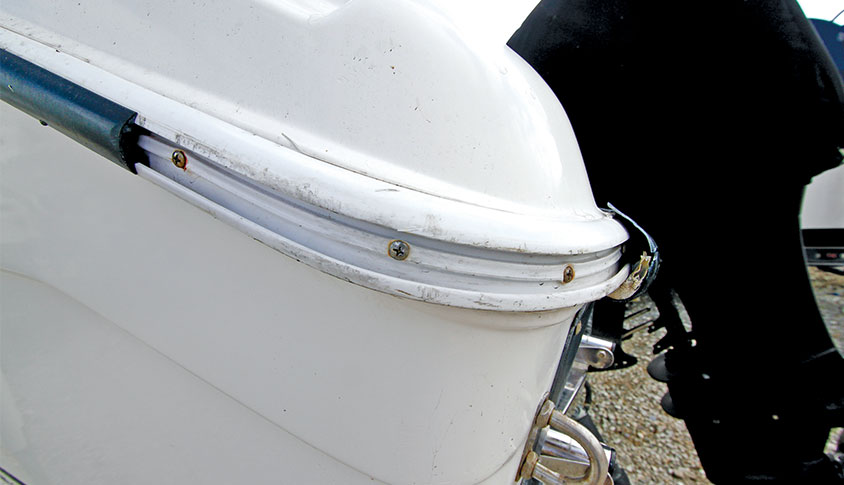Vinyl Rub Rail Repair Benefits More Than Aesthetics
Your boat comprises many different elements and needs. And with the condition of your vessel comes reputation when observed by passing boaters in the channel, especially those of a Coast Guard Auxiliary unit. In this effort, rub rails are essential for ensuring the integrity of your hull and sound gunnels. For do-it-yourselfers, Taco Marine of Miami has created the Rub Rail Replacement Guide for all of your rub rail replacement needs.

Photo: Doughertyphotos.com
Harsh marine conditions and the usual wear and tear associated with being on the water can damage and undermine all sorts of gear and equipment required for safe boating. Rub rails are no exception, especially when trusting that your hull and gunnels will stand strong to support your marine activities.
With this all-encompassing guide, your rub rail concerns are easily addressed in an extensive, handy format and really leaves nothing to chance.
With over 50 years experience in the marine industry as well as in-house engineering and technological expertise, Taco Marine sits at the top of rub rail manufacturing. So much so that the firm developed its own downloadable guide to help boaters of all types replace an integral element for boat preservation.
Using the highest grade of vinyl com-pounds, which also incorporate U.V. inhibitors, fungicides and impact modifiers, surviving the weather and elements is paramount toward Taco Marine’s manufacture of rub rails. Parts that are exposed to accelerated weather undergo extensive testing in terms of a Xenon arc weatherometer and other testing protocols.
Taco Marine’s replacement guide is comprehensive, comprising more than 40 pages. Included in the downloadable PDF file is a five-step instructional process for ordering, a list outlining the tools and supplies needed, reference index and profile insert samples of rub rails for your particular vessel. Each page is easy to read through.
Cross-referencing the original factory rub rail for over 80 of the leading boat builders since 1993—from Action Craft to Yellowfin—this five step ordering process asks you to look up the make of boat in the index; match the rub rail profile insert to your existing rail; choose the desired color, then call a Taco Marine distributor to determine availability prior to placing an order.
Adding the length and beam of your boat, and multiplying by two gives you the minimal length of rub rail to be ordered. Recommended is adding an additional ten feet to this overall amount for trial and error purposes. It’s that easy.
Getting ready for the actual replacement process will take more than a few tools and material to get the job done. Taco Marine urges attention-to-detail regarding installation as well as the overall material required for a perfect install. Some of the suggested items for the installation process: Rub rail, measuring tape, safety glasses, two cordless drills outfitted with a drill and screw bit respectively, putty knife, caulking gun with silicon sealant, metal file or sandpaper to remove burs, heat gun, garden shears or hacksaw depending on the rub rail chosen, miter box, rubber mallet, fasteners of prop-er size and type, and work gloves.
There are different types of rub rails for certain prevailing conditions and durability concerns. Flexible vinyl rails are the easiest to bend and provide cushioning for normal contact with pilings and docks. Rigid vinyl and aluminum rub rails with flexible vinyl inserts last long and are easy to install. Rigid rub rail with aluminum overlap gives the most protection while ensuring many years of durability.
Those looking for a simple method of ordering or installation have several vinyl rub rail kits to choose from. Each kit comes with a coiled rail for one piece installation without a seam, insert, applicable end caps, screws and an installation guide. Each kit comes in a variety of lengths, width, colors and style in an easy to carry retail box, which happens to comply with UPS packaging requirements.
With each design, a five-year limited warranty applies to Taco Marine’s rub rails. Within this timeframe, Taco Marine will allow repair or replacement without charge should any product be proven to be defective in material or workmanship.
Making sure nothing is overlooked, the Taco Marine website (tacomarine.com) has step-by-step instructions and how-to videos documenting the installation of the various types of rub rails you choose for your vessel. Whatever the rail chosen, the site contains an Application Support page dedicated to that particular rail, the installation method with imagery devoted to each step in the process, what materials and tools are needed to complete the project and a pro’s tips section detailing certain knowledgeable secrets for making the project as simple as the website is to navigate.
Considering Taco Marine’s aim is to make sure of purchase satisfaction, various methods with which to contact them are available should the need arise as you engage in your replacement project. A phone number, email address and contact technical support form are all there to provide avenues of communication in the event of anything going awry.
There’s even a FAQ section pertaining specifically to rub rail replacement projects. On this page are common questions regarding everything from what rub rail goes on a certain boat to reading rub rail part numbers. Also answered are questions concerning boat manufacturers who may not be listed in the PDF guide, what to do if your boat was built prior to 1993 or if your boat doesn’t have a rub rail at present but you would like to install one. Each answer provides enumerated steps and links to give you as much instruction and information as needed.
With this all-encompassing guide, your rub rail concerns are easily addressed in an extensive, handy format and really leaves nothing to chance. Thankfully, the process of replacing a rub rail has become stream-lined by the manufacturer itself, minimizing the pitfalls of such an undertaking. But with project completion, a sense of pride comes with knowing your own hands helped maintain the safety and integrity of your vessel. So, when crossing large expanses of open water you’ll have the confidence that comes with a rub rail that is designed not only with uncompromising elements and testing but with the knowledge that the manufacturer stands behind its product.
Vinyl Rub Rail Repair Benefits More Than Aesthetics
Your boat comprises many different elements and needs. And with the condition of your vessel comes reputation when observed by passing boaters in the channel, especially those of a Coast Guard Auxiliary unit. In this effort, rub rails are essential for ensuring the integrity of your hull and sound gunnels. For do-it-yourselfers, Taco Marine of Miami has created the Rub Rail Replacement Guide for all of your rub rail replacement needs.

Photo: Doughertyphotos.com
Harsh marine conditions and the usual wear and tear associated with being on the water can damage and undermine all sorts of gear and equipment required for safe boating. Rub rails are no exception, especially when trusting that your hull and gunnels will stand strong to support your marine activities.
With this all-encompassing guide, your rub rail concerns are easily addressed in an extensive, handy format and really leaves nothing to chance.
With over 50 years experience in the marine industry as well as in-house engineering and technological expertise, Taco Marine sits at the top of rub rail manufacturing. So much so that the firm developed its own downloadable guide to help boaters of all types replace an integral element for boat preservation.
Using the highest grade of vinyl com-pounds, which also incorporate U.V. inhibitors, fungicides and impact modifiers, surviving the weather and elements is paramount toward Taco Marine’s manufacture of rub rails. Parts that are exposed to accelerated weather undergo extensive testing in terms of a Xenon arc weatherometer and other testing protocols.
Taco Marine’s replacement guide is comprehensive, comprising more than 40 pages. Included in the downloadable PDF file is a five-step instructional process for ordering, a list outlining the tools and supplies needed, reference index and profile insert samples of rub rails for your particular vessel. Each page is easy to read through.
Cross-referencing the original factory rub rail for over 80 of the leading boat builders since 1993—from Action Craft to Yellowfin—this five step ordering process asks you to look up the make of boat in the index; match the rub rail profile insert to your existing rail; choose the desired color, then call a Taco Marine distributor to determine availability prior to placing an order.
Adding the length and beam of your boat, and multiplying by two gives you the minimal length of rub rail to be ordered. Recommended is adding an additional ten feet to this overall amount for trial and error purposes. It’s that easy.
Getting ready for the actual replacement process will take more than a few tools and material to get the job done. Taco Marine urges attention-to-detail regarding installation as well as the overall material required for a perfect install. Some of the suggested items for the installation process: Rub rail, measuring tape, safety glasses, two cordless drills outfitted with a drill and screw bit respectively, putty knife, caulking gun with silicon sealant, metal file or sandpaper to remove burs, heat gun, garden shears or hacksaw depending on the rub rail chosen, miter box, rubber mallet, fasteners of prop-er size and type, and work gloves.
There are different types of rub rails for certain prevailing conditions and durability concerns. Flexible vinyl rails are the easiest to bend and provide cushioning for normal contact with pilings and docks. Rigid vinyl and aluminum rub rails with flexible vinyl inserts last long and are easy to install. Rigid rub rail with aluminum overlap gives the most protection while ensuring many years of durability.
Those looking for a simple method of ordering or installation have several vinyl rub rail kits to choose from. Each kit comes with a coiled rail for one piece installation without a seam, insert, applicable end caps, screws and an installation guide. Each kit comes in a variety of lengths, width, colors and style in an easy to carry retail box, which happens to comply with UPS packaging requirements.
With each design, a five-year limited warranty applies to Taco Marine’s rub rails. Within this timeframe, Taco Marine will allow repair or replacement without charge should any product be proven to be defective in material or workmanship.
Making sure nothing is overlooked, the Taco Marine website (tacomarine.com) has step-by-step instructions and how-to videos documenting the installation of the various types of rub rails you choose for your vessel. Whatever the rail chosen, the site contains an Application Support page dedicated to that particular rail, the installation method with imagery devoted to each step in the process, what materials and tools are needed to complete the project and a pro’s tips section detailing certain knowledgeable secrets for making the project as simple as the website is to navigate.
Considering Taco Marine’s aim is to make sure of purchase satisfaction, various methods with which to contact them are available should the need arise as you engage in your replacement project. A phone number, email address and contact technical support form are all there to provide avenues of communication in the event of anything going awry.
There’s even a FAQ section pertaining specifically to rub rail replacement projects. On this page are common questions regarding everything from what rub rail goes on a certain boat to reading rub rail part numbers. Also answered are questions concerning boat manufacturers who may not be listed in the PDF guide, what to do if your boat was built prior to 1993 or if your boat doesn’t have a rub rail at present but you would like to install one. Each answer provides enumerated steps and links to give you as much instruction and information as needed.
With this all-encompassing guide, your rub rail concerns are easily addressed in an extensive, handy format and really leaves nothing to chance. Thankfully, the process of replacing a rub rail has become stream-lined by the manufacturer itself, minimizing the pitfalls of such an undertaking. But with project completion, a sense of pride comes with knowing your own hands helped maintain the safety and integrity of your vessel. So, when crossing large expanses of open water you’ll have the confidence that comes with a rub rail that is designed not only with uncompromising elements and testing but with the knowledge that the manufacturer stands behind…





